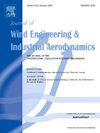Turbulence correlation between moving trains and anemometer towers: Theoretical analysis, field measurements and simulation
IF 4.2
2区 工程技术
Q1 ENGINEERING, CIVIL
Journal of Wind Engineering and Industrial Aerodynamics
Pub Date : 2024-11-09
DOI:10.1016/j.jweia.2024.105949
引用次数: 0
Abstract
A precise command of railway operations according to the measured instantaneous wind speed on an anemometer tower along a railway line is the development trend, whose challenges lie in the unknown transfer relation(s) between wind speed fluctuations on a moving train and an anemometer tower, i.e. the turbulence correlation between them. To address this issue, in the current work, the cross-correlation functions of wind speed fluctuations at the moving train and anemometer tower are derived, and an empirical formula of the coherence functions is obtained. The turbulence correlation is inversely related to the separation distance from the anemometer tower to the line, and there is little correlation when this distance is longer than double the longitudinal turbulence length scale. Field measurements of wind characteristics were carried out on an anemometer tower and a moving vehicle, and the turbulence correlation and its expression were validated. Three methods are proposed and compared to evaluate the instantaneous wind speed at the anemometer tower and moving train with this correlation. The methods based on the cross-spectral density and coherence function can accurately simulate the correlation, and the latter performance is slightly better (its simulation of the frequency domain correlation is 52.9% better than the former); the method based on solely independent and identically distributed random phases cannot fully simulate the correlation. From this, the effects of the correlation on train operations are studied and analysed in detail. Our analysis shows that neglecting this correlation leads to conservative estimates: wind speed differences between the anemometer tower and the moving train are at least 18.1% greater, and the safety and economic assessments of train operations in crosswinds are underestimated by at least 32.0%. Considering the correlation can reduce the (excess) safety risk/margin and is an inevitable development of adapting to the detailed assessment of the crosswind stability of vehicles. The quantitative description and simulation of the correlation presented in this work point to the critical importance of wind speed monitoring systems for the detailed crosswind assessment, and provide a theoretical basis for further research work on the crosswind stability of vehicles under true/realistic turbulent flow wind.
动车组与风速计塔之间的湍流相关性:理论分析、实地测量和模拟
根据铁路沿线风速仪塔上测得的瞬时风速精确指挥铁路运行是发展趋势,其挑战在于动车组和风速仪塔上风速波动之间的未知传递关系,即两者之间的湍流相关性。针对这一问题,本研究推导了动车组和风速计塔上风速波动的交叉相关函数,并获得了相干函数的经验公式。湍流相关性与风速计塔到线路的分离距离成反比,当这一距离超过纵向湍流长度尺度的两倍时,相关性很小。在风速计塔和移动车辆上对风特性进行了实地测量,并验证了湍流相关性及其表达式。提出了三种方法,并通过比较这三种方法来评估风速计塔和移动列车上的瞬时风速。基于交叉谱密度和相干函数的方法可以准确模拟相关性,后者的性能稍好一些(其频域相关性模拟比前者好 52.9%);基于完全独立且同分布随机相位的方法不能完全模拟相关性。由此,我们详细研究和分析了相关性对列车运行的影响。我们的分析表明,忽略这种相关性会导致保守的估计:风速计塔和移动列车之间的风速差至少要大 18.1%,横风中列车运行的安全和经济评估至少要低估 32.0%。考虑相关性可以降低(超额)安全风险/利润,是适应车辆横风稳定性详细评估的必然发展。本研究对相关性的定量描述和模拟表明,风速监测系统对详细的横风评估至关重要,并为进一步研究车辆在真实/现实湍流风下的横风稳定性提供了理论基础。
本文章由计算机程序翻译,如有差异,请以英文原文为准。
求助全文
约1分钟内获得全文
求助全文
来源期刊
CiteScore
8.90
自引率
22.90%
发文量
306
审稿时长
4.4 months
期刊介绍:
The objective of the journal is to provide a means for the publication and interchange of information, on an international basis, on all those aspects of wind engineering that are included in the activities of the International Association for Wind Engineering http://www.iawe.org/. These are: social and economic impact of wind effects; wind characteristics and structure, local wind environments, wind loads and structural response, diffusion, pollutant dispersion and matter transport, wind effects on building heat loss and ventilation, wind effects on transport systems, aerodynamic aspects of wind energy generation, and codification of wind effects.
Papers on these subjects describing full-scale measurements, wind-tunnel simulation studies, computational or theoretical methods are published, as well as papers dealing with the development of techniques and apparatus for wind engineering experiments.

 求助内容:
求助内容: 应助结果提醒方式:
应助结果提醒方式:


